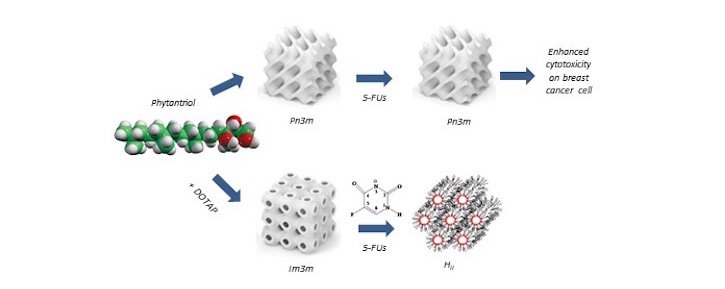New class of nanoparticles developed towards more effective cancer treatment
|Latest research at CERIC develops a new system for drug delivery to tumour cells by nanoparticles , for new and more effective chemotherapy agents.
Cancer is one of the most common causes of death in developed countries. Due to the increasing average age of the population, the new cases of cancer are rapidly increasing, and the fight against it is one of the highest priorities in medical research worldwide.
Cancer is usually treated by a combination of chemotherapy with other forms of therapy. Chemotherapy usually uses drugs targeting cancer cells and hindering their procreation. Since cancer cells are very similar to normal cells, also the healthy ones are usually affected. This results in very harsh side effect and irreversible damage to the healthy tissues. To minimise them, the dosage of drugs used in chemotherapy should be lowered. For this reason, researches are constantly looking for ways to use anti-cancer drugs in a more targeted way, to harm the cancer and keep the non-infected organs healthy.
In recent years, nanomedicine has raised wider attention among the scientific community. As the name hints, nanomedicine is the use of nanotechnology for medical purposes. The main idea behind drug carriers developed in nanomedicine is to load the drug into a nanoparticle and inject it into the body. Nanoparticles are much smaller than cells and they can be functionalised so that they can “detect” and target tumour cells without too much harm for the neighbouring tissues. Although in the past decades great progress has been made in nanomedicine, there are still problems to be solved. One of them is to find a stable enough structure able to survive the conditions in the human body, and also to take up and release the active drug.

The research group around Michela Pisani, CERIC user from the Università Politecnica delle Marche in Ancona, Italy, recently developed a new class of nanoparticles that has promising properties as drug carriers. They created nanoparticles from Phytantriol, a substance widely used in cosmetics, to load them with drugs. Phytantriol is an amphiphilic (i.e., possessing both hydrophilic and lipophilic properties) molecule having one side soluble in water, and one that is not. In the presence of water, the substance forms structures that minimise the contact with water of the insoluble side. The effect, taking place at the nanometric level, is comparable to oil forming droplets on the surface of a soup. In particular, Phytantriol formed nano-structures with intricate networks of aqueous channels into which the commercial chemotherapy agent specifically used can be loaded and unloaded. To analyse the structure and the ability to take up drugs, the researchers used a combination of Synchrotron SAXS, Infrared, and UV spectroscopy, available at the Austrian and Italian CERIC Partner Facilities, at the TU Graz and at Elettra Sincrotrone respectively. After having found a suitable formulation, they conducted laboratory tests on human breast cancer cells. Results showed a slightly higher effectivity of the anti-cancer drug in combination with the nanoparticles than without. It is still a long way until these substances can be used in a regular therapy. However, these results are a promising first step towards the development of new chemotherapy systems.



